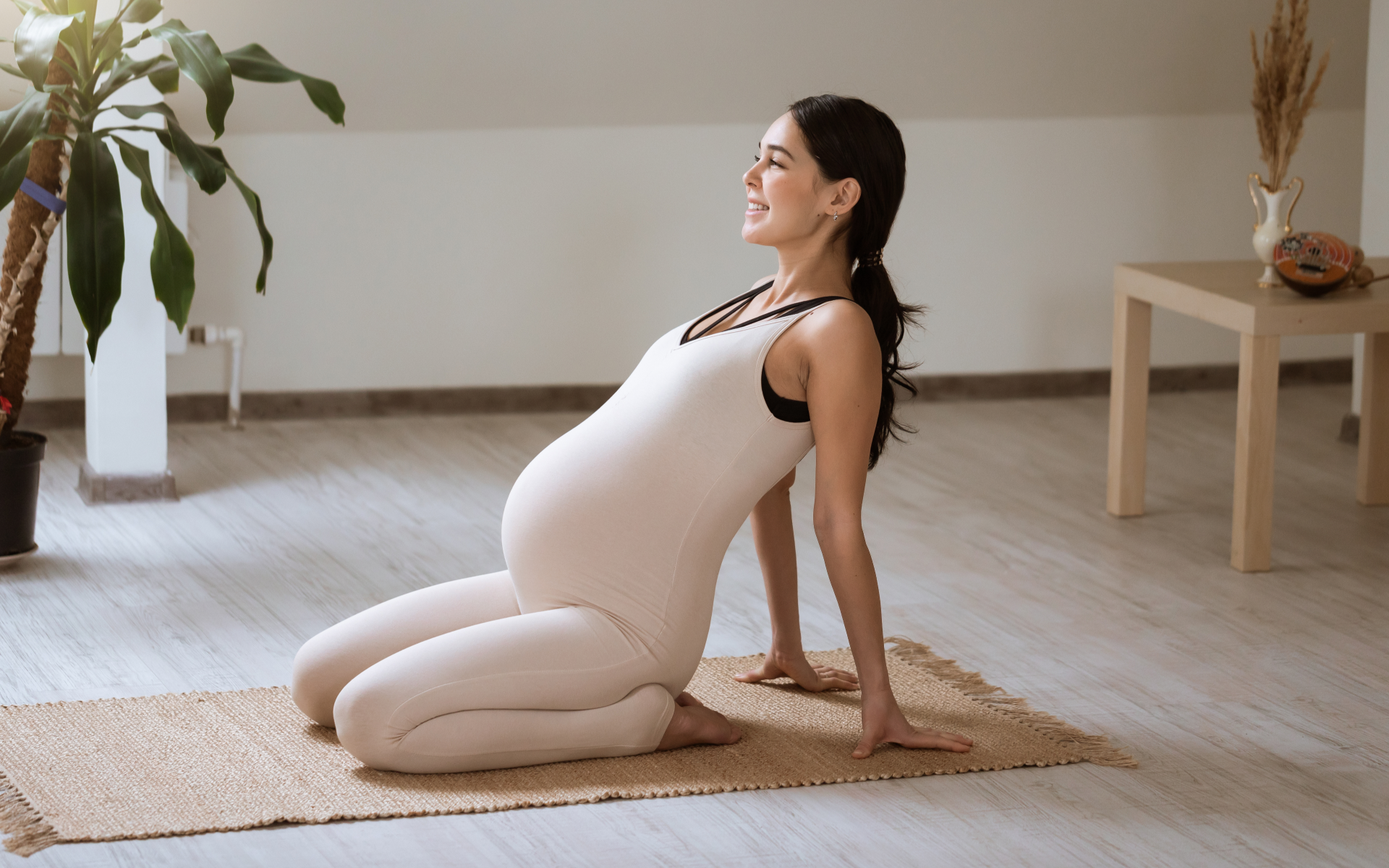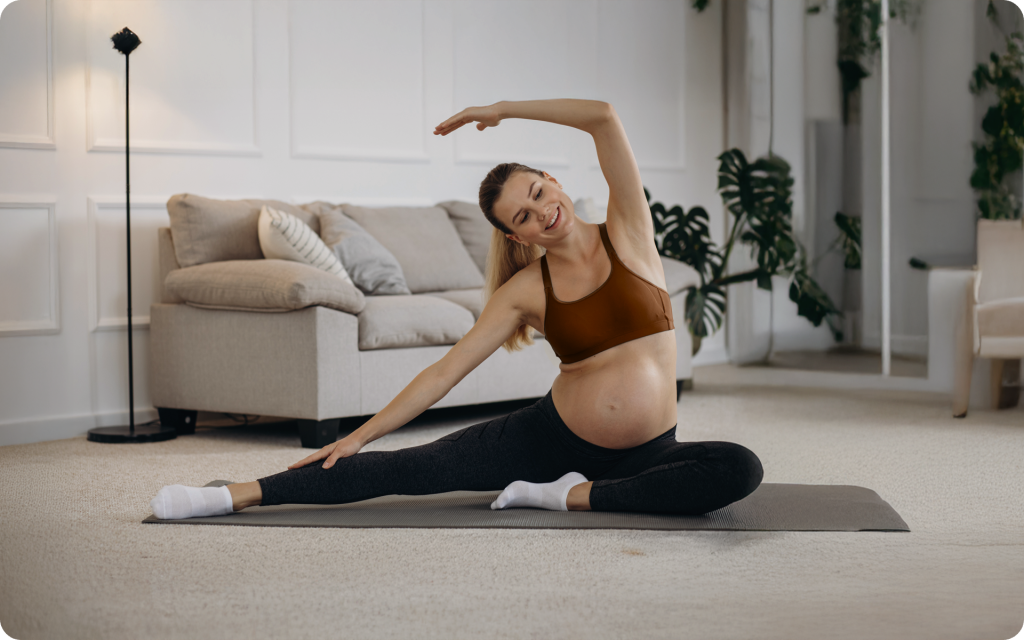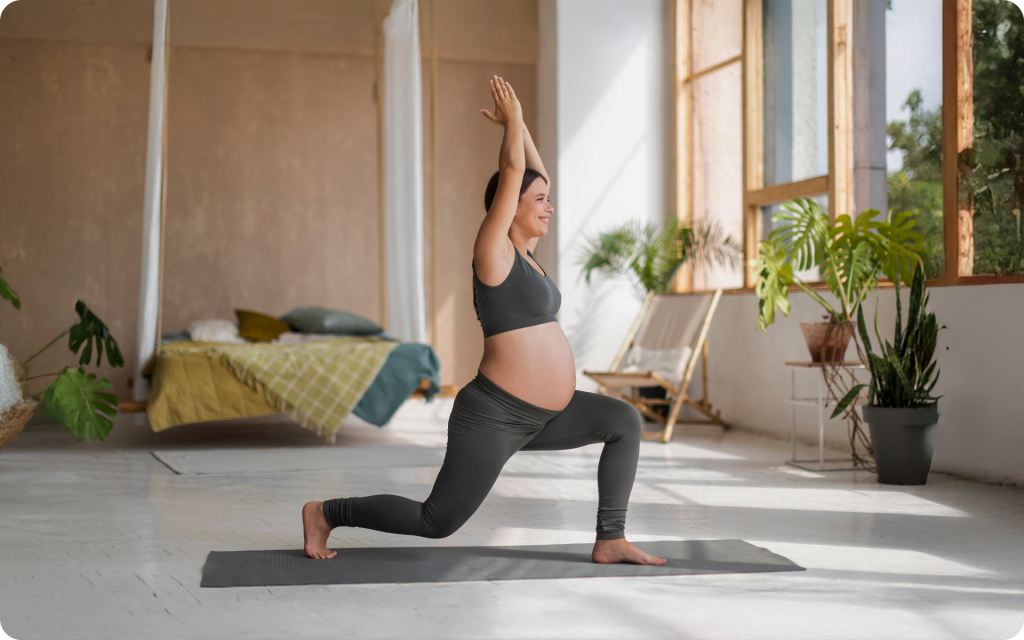When it comes to staying fit while pregnant, there are mixed opinions. Some people say you should follow your usual fitness regimen and exercise like normal, while others say you had better take it easy.
While many women worry that continuing their exercise routines while pregnant will negatively impact their baby, research has suggested otherwise. In fact, many women who exercise during their pregnancies have reported feeling less tired and having more energy than those who don’t.
Generally, it’s best to follow your doctor’s advice about fitness during pregnancy. Pregnancy can have a profound effect on your body and it’s important to make sure you’re healthy enough for exercise.
If your doctor gives you the go-ahead, remember that your baby needs you to take care of yourself. If that means following a less strenuous fitness program than usual, then that’s what you should do.
The Benefits of Getting in Shape While Pregnant
Contrary to what many people believe, exercising while pregnant can actually be healthy for both you and your baby (1). Keep these benefits in mind when it comes to prenatal fitness:
- Maintaining a Healthy Body Weight
One of the best things about exercise during pregnancy is that it keeps your weight under control (2). This is good for your health – studies have shown that mothers who stay fit during pregnancy are less likely to develop gestational diabetes.
- Reduced Stress and Anxiety
Moms-to-be may find it difficult to stay fit when they feel ill, exhausted, stressed, or depressed. However, exercise can reduce these symptoms by releasing endorphins – chemicals that elevate your mood and relax your body (3).
- Better Sleep
Staying fit during pregnancy has several health benefits, including better sleep (4).
Exercise can help you get more shut-eye at night, so you feel refreshed when you wake up.
- Fewer Digestive Issues
As your baby grows, you may have more pressure on your stomach and intestines, which can lead to uncomfortable symptoms such as constipation (5). Exercise works to ease these symptoms by helping you digest your food better.
- Reduced Swelling
Pregnancy puts a lot of pressure on the veins that carry blood into and out of the uterus. This results in swelling in the legs and feet, which can be uncomfortable. Exercise helps reduce this swelling by improving blood flow to your lower body (6).
- Reduced Backache
Staying active during pregnancy also reduces backache and other pains that may develop as a result of the extra weight you’re carrying around (7).
- Increased Energy
Pregnancy is exhausting for most women. With the added demands of daily life and a developing baby, many moms-to-be look forward to yoga and other restorative exercises.
- Better Able to Cope with Labor and Delivery
By staying fit, you’re training your body to better handle the physical stress of pregnancy and childbirth. Regular exercise during pregnancy makes it easier to get through labor and delivery (8).
- Easier to Get Back in Shape After Delivery
Generally, moms who are physically active during their pregnancy find it easier to get back in shape after giving birth. They recover more quickly than others and are less likely to experience the negative side effects of pregnancy. If you’re curious about core exercises postpartum, check out our earlier article.
Read more: Pregnancy Cardio Workout: Everything You Need to Know to Do It Safely
What’s Safe and What’s Not When Pregnant
Before you start an exercise program, you should consult your doctor to see if pregnancy exercise is recommended for you. Your doctor can also help determine what exercises are appropriate once you’ve conceived.
The first trimester is the time when most pregnant women experience morning sickness, fatigue, and other symptoms that make it difficult for them to continue their usual fitness routines (9).
However, if you can muster the energy, your doctor may recommend light exercise such as walking. Once the nausea and fatigue subside, women who exercise before and during their first trimester usually go back to their normal fitness activities.
It’s generally best to avoid strenuous workouts such as running and high-impact aerobics until after your second trimester. However, doing low-impact workouts such as yoga or swimming can be safe during your entire pregnancy.
Here are some pregnancy-safe exercises you can do:
Walking
Walking is by far the most common form of exercise that is recommended for pregnant women.
With your doctor’s approval, you can start a walking program two weeks after conception and aim for 30-minute sessions at least three times a week. Depending on your fitness level, you may want to warm up with a five-minute walk and cool down with a five-minute walk.
Hold stretches for 15 to 30 seconds, relax, and then repeat each stretch three times.
If you’re fighting morning sickness, try going out in the evening when it’s cooler.
You can increase the intensity of your walk by carrying light dumbbells, speeding up your pace, or going uphill.
Reasons why BetterMe is a safe bet: a wide range of calorie-blasting workouts, finger-licking recipes, 24/7 support, challenges that’ll keep you on your best game, and that just scratches the surface! Start using our app and watch the magic happen.
Yoga
Yoga includes a wide range of stretching exercises that have been specifically designed for pregnant women.
If you’re new to yoga, start with basic poses such as downward-facing dog. Once you’ve mastered this basic pose, you can move on to challenging yoga asanas, such as the warrior pose.
To avoid overheating, choose a room with air conditioning or open a window if it’s warm. You can exercise in loose clothing and wear comfortable yoga pants.
Swimming
Water exercises are ideal for pregnant women as they are gentle on the joints, help improve blood flow, and are good for the baby (10). As with most low impact exercises, water exercises are safe throughout your pregnancy.
If you enjoy hot tubs and saunas, you should avoid them while pregnant, especially in the first 12 weeks. According to the NHS, they increase the risk of overheating, dehydration, and fainting (11).
Research also shows that prolonged use of hot tubs in early pregnancy may increase the risk of certain birth defects (12).
Dancing
Dancing is an excellent way to enjoy music while you exercise. It’s a great cardio workout that exercises your arms, legs, and abdomen. You can do this with a partner or take a dance class.
Just make sure that the dance moves are low-impact and you don’t overheat while exercising in highly crowded, closed rooms or doing strenuous dances such as aerobics.
Strength Training
When you think of strength training, free weights and weight machines usually come to mind. However, there are many creative ways you can do this type of exercise during pregnancy. For example, you can use elastic bands or hand weights to tone your arms and shoulders. You can also use your body weight.
Some exercises you can do include:
- Squats – These target your glutes, quadriceps, hamstrings, and calves.
- Wall sits – These are great for toning your leg muscles.
- Leg lifts – These work out your abdominal muscles.
- Tricep dips on a chair – These work out the triceps and shoulders.
- Seated dumbbell row – These work out your back.
Make sure to slowly build up the number of repetitions you do during each workout session, particularly if you’re starting a new exercise routine after taking some time off.
If you’ve been active before pregnancy, chances are you can continue most of your activities throughout your entire pregnancy. However, you must take it easy so you don’t overdo it. Always work out under the supervision of a trained professional and within the limits your doctor sets for you (13).
When doing any type of strength training program during pregnancy, you should remember these essentials:
- Warm-up – Two to three minutes of low-intensity, easy warm-up exercises should be part of your routine.
- Breathe – Always remember to inhale and exhale while you exercise. Never hold your breath.
- Safety – Avoid exercises that place excessive stress or strain on your body because this may hurt the baby. Be particularly cautious of exercises that put you at risk of falling.
- Good posture – Maintain good posture when you’re exercising, especially when performing weight-bearing activities such as squats, lunges, chest presses, and overhead presses.
BetterMe: Health Coaching app helps you achieve your body goals with ease and efficiency by helping to choose proper meal plans and effective workouts. Start using our app and you will see good results in a short time.
Pelvic Floor Exercises
These exercises target the muscles in your pelvic floor, which help support the uterus and bladder.
Pregnancy and childbirth can weaken these muscles, which increases your risk of bladder incontinence and other pelvic health issues (14).
One common pelvic floor exercise you can do is the kegel. To do this exercise:
- Tighten the muscles of your pelvic floor as if stopping a stream of urine.
- Relax your muscles for a count of three and repeat 10 to 15 times a day.
- This can be done while sitting at home or when you’re on the go.
Remember that you should never tighten these muscles when you’re urinating because this may interfere with the bladder’s ability to empty completely.
Read more: 7-Week Pregnancy Diet: How to Get the Best Nutrition for You and Your Baby
Exercises to Avoid During Pregnancy
Here are some exercises you should steer clear of while pregnant (1):
- Heavy Lifting
If you’ve never lifted heavy weights before, pregnancy isn’t the time to start. You can seriously hurt yourself or your baby, no matter how strong you are.
- Contact Sports
Sports such as football, soccer, basketball, and horseback riding involve a lot of running and jumping. Many high-impact sports put excessive stress on the abdominal area, which can be harmful for the baby. Ask your doctor if the sport you’re interested in is safe for pregnant women.
Keeping Fit During Pregnancy: Diet Is Also Important
While exercise is definitely important when it comes to pregnancy fitness, you shouldn’t neglect your diet. Eating healthy foods is the key to both your and your baby’s health (15).
There is a popular myth that says pregnant women should “eat for two”. This is false. Women should only eat the amount of food they need for their daily activities, which includes exercise and carrying a baby.
How many calories should you eat? The answer depends on how far along you are in your pregnancy, how much you weigh before becoming pregnant, and whether or not you’re exercising.
With that said, the general guidelines are as follows (16, 17):
- First trimester – Keep your daily caloric intake the same as usual.
- Second trimester – Increase your average daily calorie intake by 340 calories.
- Third trimester – Add an extra 110 calories to your second-trimester intake.
You should keep in mind that eating more doesn’t necessarily mean you’re eating better. You should eat nutritious foods that are high in protein, calcium, and other vital nutrients. Although diet alone can’t replace prenatal vitamins (which can be found in most pharmacies or supermarkets), eating healthily will do wonders for both you and your baby. For more details about the pregnancy diet menu, take a look at our prior publication.
Here are some of the most nutritious foods you can use to fuel your body:
- High-Quality Protein
Lean meats, eggs, and seafood are all excellent sources of protein. When it comes to seafood, you should avoid eating shark, swordfish, and king mackerel as they contain high levels of mercury. Make sure to get enough protein every day (18).
- Fruits and Vegetables
Fresh fruits and vegetables have a high nutrient content. They also help prevent constipation while providing fiber that cleanses the digestive tract.
The World Health Organization recommends you aim for at least four servings of fruits and vegetables every day (19). If you’re unable to get your daily servings of fruits and vegetables, consider taking vitamin supplements.
- Whole Grains
You can get your carbohydrates from whole grains such as brown rice, whole-wheat bread, and 100 percent whole-wheat pasta. Whole grains help keep your blood sugar stable and provide you with the energy you need to get through your day.
- Healthy Fats
It’s best to avoid saturated fats that can be found in processed foods or fast food as they increase your risk of cardiovascular diseases. Instead, choose polyunsaturated and monounsaturated good fats such as those found in olive oil, peanut butter, avocados, and salmon.
The American Heart Association recommends eating fish twice a week to get the benefits of omega-3 fatty acids (20).
- Water and Fluids
You should drink at least 8-10 glasses (at least 64 ounces) of water every day to stay hydrated and flush out toxins in your system. You can also drink unsweetened tea, juice, and other clear liquids to avoid dehydration.
Caffeine Intake
It is no secret that a high consumption of caffeine could lead to adverse pregnancy complications. However, this does not mean that pregnant women should avoid caffeine altogether.
Research shows that moderate caffeine intake while expectant will not lead to these adverse complications. The World Health Organisation recommends a daily intake of 200-300 mg a day for expectant mothers (21). However, since this intake may be too high for some (21), it may be safer to limit your daily intake to less than 200 mg/day (22).
Quit Smoking and Other Unhealthy Habits
Smoking, the intake of alcohol, and other illicit substances have been associated with adverse pregnancy effects, both to the mother and the unborn fetus (23, 24, 25). Such substances should be avoided at conception, throughout pregnancy, and even after birth for the safety of the mother and child.
The Bottom Line
Moms-to-be need to understand that the effects of prenatal fitness extend far beyond pregnancy. Not only does it make it easier for you to recover from labor and delivery, it makes it easier to get back in shape afterward. Pregnancy fitness is all about being healthy, so you and your baby can benefit for years to come.
DISCLAIMER:
This article is intended for general informational purposes only and does not serve to address individual circumstances. It is not a substitute for professional advice or help and should not be relied on for making any kind of decision-making. Any action taken as a direct or indirect result of the information in this article is entirely at your own risk and is your sole responsibility.
BetterMe, its content staff, and its medical advisors accept no responsibility for inaccuracies, errors, misstatements, inconsistencies, or omissions and specifically disclaim any liability, loss or risk, personal, professional or otherwise, which may be incurred as a consequence, directly or indirectly, of the use and/or application of any content.
You should always seek the advice of your physician or other qualified health provider with any questions you may have regarding a medical condition or your specific situation. Never disregard professional medical advice or delay seeking it because of BetterMe content. If you suspect or think you may have a medical emergency, call your doctor.
SOURCES:
- Exercise in Pregnancy (2015, ncbi.nlm.nih.gov)
- Exercise in pregnant women and birth weight: a randomized controlled trial (2011, biomedcentral.com)
- Impact of prenatal exercise on both prenatal and postnatal anxiety and depressive symptoms: a systematic review and meta-analysis (2018, pubmed.ncbi.nlm.nih.gov)
- Effects of Exercise on Sleep Quality in Pregnant Women: A Systematic Review and Meta-analysis of Randomized Controlled Trials (2020, sciencedirect.com)
- Gastrointestinal diseases during pregnancy: what does the gastroenterologist need to know? (2018, ncbi.nlm.nih.gov)
- Response of pregnancy leg edema to a single immersion exercise session (2005, onlinelibrary.wiley.com)
- Back Pain During Pregnancy (2020, acog.org)
- Association between aerobic fitness in late pregnancy and duration of labor in nulliparous women (2010, onlinelibrary.wiley.com)
- Examining to what extent pregnancy-related physical symptoms worry women in the first trimester of pregnancy: a cross-sectional study in general practice (2019, ncbi.nlm.nih.gov)
- Maternal swimming pool exposure during pregnancy in relation to birth outcomes and cord blood DNA methylation among private well users (2019, sciencedirect.com)
- Health things you should know in pregnancy (2022, nhs.uk)
- Maternal use of hot tub and major structural birth defects (2011, pubmed.ncbi.nlm.nih.gov)
- Safety and Efficacy of Supervised Strength Training Adopted in Pregnancy (2011, ncbi.nlm.nih.gov)
- Vaginal Childbirth and Pelvic Floor Disorders (2013, journals.sagepub.com)
- Nutrition During Pregnancy, Lactation and Early Childhood and its Implications for Maternal and Long-Term Child Health: The Early Nutrition Project Recommendations (2019, karger.com)
- Nutrition During Pregnancy (2023, acog.org)
- Nutrition Recommendations in Pregnancy and Lactation (2017, pmc.ncbi.nlm.nih.gov)
- Protein and Amino Acid Requirements during Pregnancy (2016, advances.nutrition.org)
- Fruit and Vegetable Intake: Benefits and Progress of Nutrition Education Interventions- Narrative Review Article (2015, ncbi.nlm.nih.gov)
- Fish and Omega-3 Fatty Acids (2021, heart.org)
- Impacts of Caffeine during Pregnancy (2021, pmc.ncbi.nlm.nih.gov)
- Moderate Caffeine Consumption During Pregnancy (2010, acog.org)
- Smoking during pregnancy and harm reduction in birth weight: a cross-sectional study (2018, bmcpregnancychildbirth.biomedcentral.com)
- Alcohol Use in Pregnancy (2020, pmc.ncbi.nlm.nih.gov)
- Increase abstinence from illicit drugs among pregnant women (2019, odphp.health.gov)















